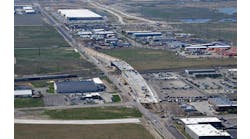By Kurt Stiles, Contributing Author
In 2001, I was a newly minted “visualization engineer” at the Washington State Department of Transportation (WSDOT).
After working years in traffic and structural design, I attended my first public open house presentation late that summer, at the civic center in Ocean Shores, Wash.
I was responsible for showing the third and final presentation — a future roundabout design — as accurately as the consultant engineers designed. The project that had stirred up quite a buzz in the community, and our team was passionate about bringing innovative solutions to this tourist and retirement community.
I didn’t know this at the time, but I was about the have a career-changing experience.
Everyone on the panel presented their parts of the project, with the citizens sitting in silence. Then it was my turn to present, right before the city voted to either build or not build the roundabout.
During the two previous open houses, residents were divided. Some seemed to struggle to imagine how a roundabout could transform their main intersection, which suffered from congestion and collisions.
I took a deep breath and presented the design through a series of static renderings. I displayed the proposed roundabout from different angle and discussed the design from many different points of view.
People murmured as they examined the images. The roundabout's elegant curves and landscaping designs had the power to evoke awe. However, it was the vibrant, lifelike static renderings that truly captured their attention.
It was as if the audience was looking into a crystal ball, seeing the future of Ocean Shores.
I could feel the atmosphere in the room shifting. Along with other team members, I spoke about the accuracy of the visualization. Eyes opened wider, and during the question-and-answer session, more and more heads nodded.
One rendering showed the roundabout with lush landscaping and a splitter island protected crosswalks. It was an image of beauty and functionality, and it made the residents see the project's intent.
It was as if the audience members were there, driving through the new roundabout, feeling the reduced traffic congestion, and experiencing the town's transformation firsthand.
The room hummed with excitement as people began to grasp the potential of their project.
After my presentation, people voted, and then they were free to leave. As I helped put chairs away, several people approached and expressed how much they liked the visualizations.
The comments have been burned into my memory: “We could see the future, accurately.” … “This brought everyone to the same understanding.” … “We weren't living in our opinions anymore; we could see the design just like the engineers did.” … “We agree, Ocean Shores needs this roundabout! Thank you!”
That moment was a turning point for me. The static renderings had brought the community together, transcending the gap between engineers and residents. It was a testament to the power of visualization in the world of civil engineering.
This encounter motivated me to explore and harness the full potential of sharing project intent through the 3D design model.
Six years later, I built my own group at WSDOT, and we have been a leading voice in the cause for visually communicating engineering design across the state and nation.
In our increasingly complex and interconnected world, civil engineers must embrace the power of visualization as part of an overall project engagement plan.
Project engagement can be defined as deliberate communication that elicits collaborative conversations that lead to proactive project design outcomes. Often on large projects, communication staff will be brought in for supporting engagement efforts with the design team.
However, they usually lack visualization-based media content to visually describe project intent. This is where 3D modeling for visualization takes center stage and becomes a go-to solution for establishing project understanding.
Indeed, these engagements, filled with static renderings and animated views of 3D design models, are not just tools but also social bridges that connect us with our communities, project partners, and stakeholders.
Here are some compelling reasons to craft strategic engagement plans filled with visualization-based content:
Focus and Clarity: Visualization simplifies complex technical designs, making them accessible to a broader audience. It creates a common understanding among internal engineering team members and external stakeholders.
Meaningful Storytelling: Static renderings and animated views captivate the imagination, drawing any audience into the project's story. This fosters their involvement, builds inclusiveness and project support through partnerships.
Build It Right: When projects get overly complicated, it’s good to check for clashing as well as constructability. Large projects often have different designers and sometimes one group’s design conflicts with another’s, especially where they join. By building the whole project in 3D, those areas are checked to see if they can be built without future change-orders.
Transparency: Visualization showcases the design's potential, highlighting benefits that may be less evident on traditional 2D plans. When engaging different project audiences, the project design-truth can be easily displayed and understood.
Confidence and Trust Building: Seeing is believing. Rendered visualizations instill confidence and trust in the project, instigating more favorable outcomes for consent, permitting, and funding.
Now, as engineering managers, it is crucial to harness these tools effectively. Your 3D design model can be worked into visualization productions that assist you in your face-to-face engagements or can be produced in such a way to provide all the heavy lifting for your project communication.
You can provide some of these products yourself through your 3D design model and software (using professional visualization services or a fusion of both). Here are a few types of visualization productions that your engagement plan can use:
Static Renderings: These offer 2D or 3D images of the design, often with materials (asphalt, concrete, steel, etc.) added and some lighting. They are perfect for conveying any aspect of the design. Project design groups can often provide their own renderings in one form or another. These renderings can be basic to detailed – the decision on which to use lies in what is to be visually understood by the viewer.
Animated Views: These take the viewer on a journey through the project. Animated flythroughs and walkthroughs provide a dynamic perspective, a passage of time, a construction sequence, or aspects of motion as part of the design, like a lift-bridge in operation. Some animations are simple to make but there might be a reason to call-in the experts if the project storytelling is complex.
Robust Video Production: Create compelling stories through video, incorporating static renderings, animations, and live-action footage with hosting or a voice-over narration is perhaps the most compelling form of project engagement. Being able to tell any aspect of the project to a mass audience requires expert production, but your group will receive great dividends in project understanding and consent.
Real-Time Visualizations: When it comes to face-to-face meetings where the conversation is about an aspect of the 3D design model, being able to see that design interactively is imperative for sharing and gaining understanding. This can be achieved by using your own design software and sharing your screen or projecting onto a screen in a conference room while at the same time discussing what is being shown. It can also be achieved by other software that have that capability.
Online Virtual Project Tours: Following the pandemic, the use of virtual meetings or engagement is here to stay. This includes simple team meetings all the way to major project “open houses” to the public. Therefore, being able to share the 3D visualization production virtually is necessary if project stories are going to be told correctly. Good news: there are services that provide this beyond websites and social media. The project design group can take the 3D visualization productions and work them into online virtual tours that describe aspects of the design. These tours, if edited correctly, can be powerful storytelling tools that can inform the masses while being easy on a project’s pocketbook.
Please remember, it's not about just “checking a box” on a meeting agenda when using visualizations; it's about building project belief by telling its unique story.
Visualizing engineering design is a critical aspect of a project’s design and execution. It enhances communication, aids in decision-making, improves collaboration, and ultimately contributes to the success of the project. It should be integrated into the engagement plan from the earliest stages and maintained throughout the project lifecycle.
I’m only skimming the surface on visually communicating infrastructure change. Beyond writing more on this subject, I’ll add this one principle, written by the University of Buffalo: “Use the right visualization at the right time to the right audience for the right reason.” Trust me, it works every time.
In the summer of 2001, the power of visual communication reached its zenith in Ocean Shores. The town not only overwhelmingly voted for building the roundabout, but it also learned a valuable lesson: the future is better understood when we all can see it accurately. RB
Kurt Stiles built and is the manager of the Visual Engineering Resource Group (VERG) at the Washington State Department of Transportation. He can be reached at: [email protected].



